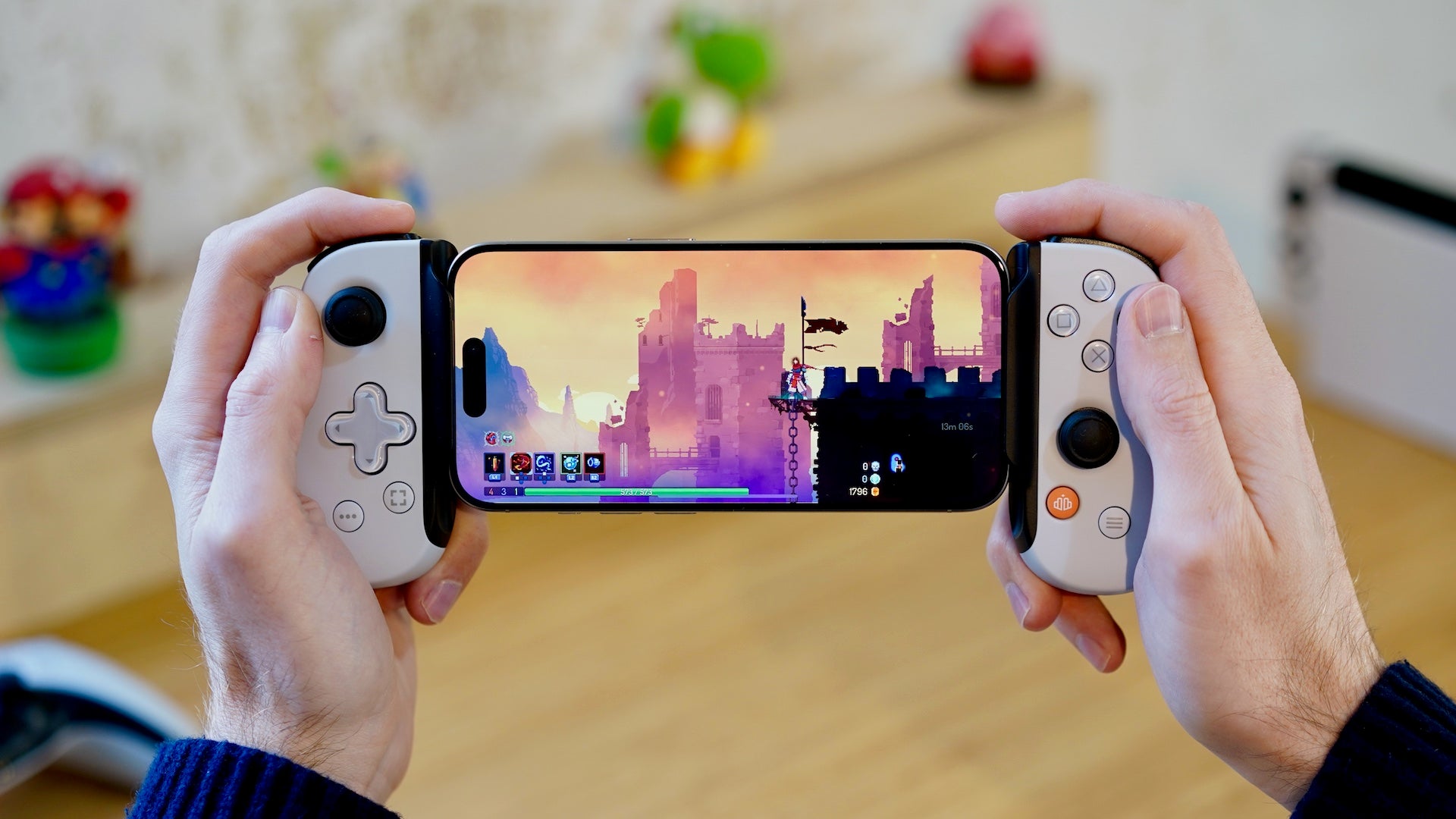Verdict
The Backbone One (2023) is a subtle revision of the original, but it remains the best and most flexible mobile controller in the business – now with improved hardware compatibility.
Pros
- Excellent mobile gaming controls
- Improved and updated hardware compatibility
- Excellent all-encompassing UI
Cons
- Still expensive
- Can be fiddly to fit your phone
- Not very different from the original
-
Compatibility with all USB-C phonesYou can connect the Backbone One (2023) to all Android phones and the new iPhone 15 range via USB-C. -
No charging requiredThe Backbone One doesn’t require any power, though it does have a USB-C port for passthrough phone charging. -
Custom UIThe Backbone app offers a window onto all of your installed games and streaming services.
Introduction
The original Backbone One was and continues to be one of the best mobile gaming controllers on the market, but it’s getting on a bit now. It was beginning to look a little outdated and inflexible, at least from a hardware compatibility standpoint.
Cue the Backbone One (2023), with a small but meaningful list of improvements that promise to open the controller out to the entire current generation of smartphones.
Together with the subsequent arrival of a dedicated PlayStation edition, and a number of improvements to its clever streaming-focused software, we thought now would be the perfect time to revisit the Backbone One. Is it still the cream of the mobile gaming crop?
At the same price of £99.99, it still isn’t anyone’s idea of cheap. But in a world where the PlayStation Portal costs £200, can it now be considered good value?
Design
- Very similar to other models
- Prosaic but effective expansion system
- No power required
The Backbone One (2023) hasn’t changed much from the design of the original, which is absolutely fine. The first-generation product was arguably the best mobile game controller on the market, so a subtle revision is all that was needed.
This is still a simple controller with a contemporary console layout that expands and clamps onto your smartphone, gripping either side in a landscape orientation. The final amalgamation looks somewhat like a smaller Nintendo Switch, but with the only point of meaningful connection being the USB-C port on the right-hand control section.
Yes, in a post-iPhone 15 world, Backbone has gone all-in on USB-C. This current model is compatible with Apple’s latest smartphones out of the box, though older USB-C owners can also get in on the act via a software update.
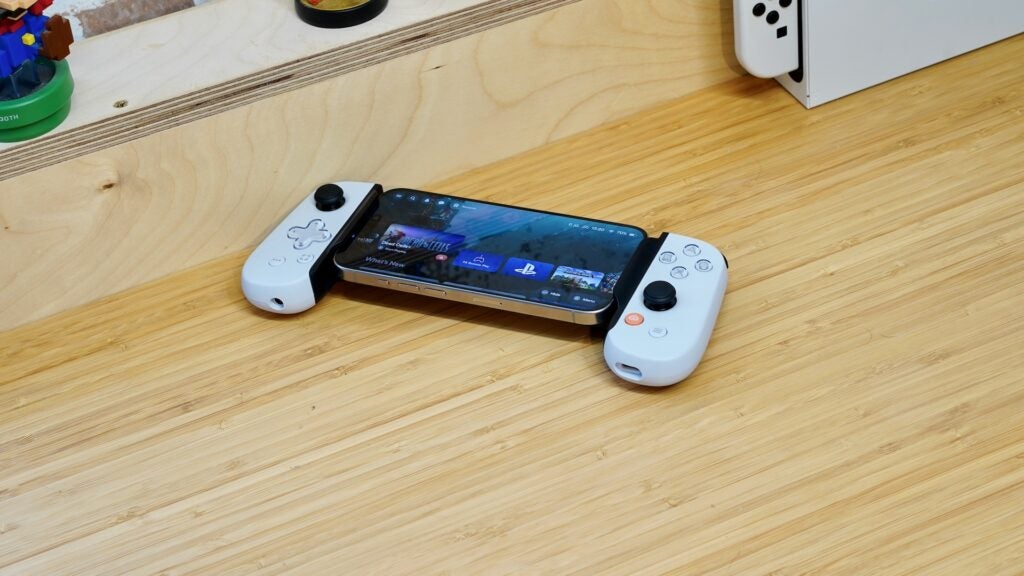
Improved compatibility is the main reason for this revised model’s existence. Besides that USB-C port, the revised model has also slightly extended the bridge extension to make fitting larger phones that little bit more comfortable – though it’s still a bit of a fiddle until you get the knack.
I would have liked Backbone to have incorporated some kind of open lock and a gradual contraction system, as it always feels like I’m a slip away from a dinged phone frame (though this fear hasn’t yet manifested itself in reality).
Also new is the addition of swappable magnetic adapters. These clever little snap-on rubberised mounts come in two flavours, and help incorporate a wider range of phones. They too are a little fiddly to root out of their mountings, but I suppose that’s preferable to being too easy to remove.
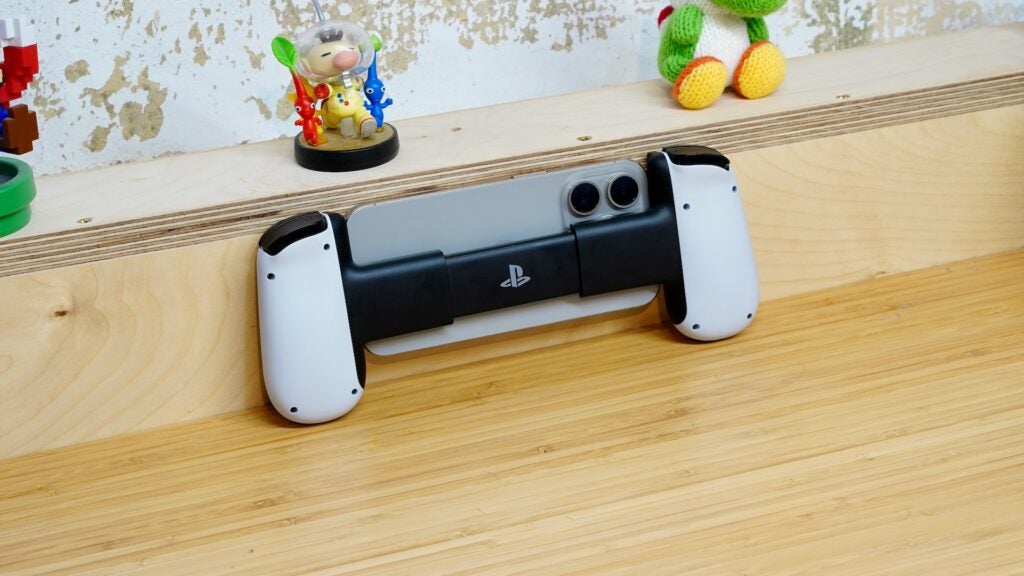
My iPhone 15 Pro fit like a glove right out of the box. I found that neither magnetic set fitted the Pixel 8, with the left grip sticking on the chunky camera module before it could clamp onto the edge. My solution was to take the magnetic grips out entirely and use the Pixel 8 case, which worked nicely.
This is the PlayStation Edition of the Backbone One (2023), but Backbone’s claim that it’s “Inspired by the look and feel of the PS DualSense” seems fanciful. It’s a simple cosmetic decal switch, with a white and black finish and the signature PlayStation button names swapping in for the Xbox layout of the original.
You still get a 3.5mm headphone jack and a USB-C port on the bottom of the left and right handles respectively. The latter is there purely for passthrough charging of your phone, as the Backbone One (2023) doesn’t require any power of its own.
Performance and gaming experience
- Superb console-like gaming controls
- Slightly improved D-pad and buttons
- Top-notch build quality
Besides the aforementioned compatibility-based updates, the only other physical changes here relate to the physical controls. The 2nd gen controller D-pad and face buttons have been updated for additional precision.
Not that I would necessarily have noticed had Backbone not drawn attention to the fact. But yes, upon closer inspection and direct comparison with the first Backbone One, the D-pad seems to offer a more pronounced edge, while the buttons have a less tightly sprung clickiness to them.
Essentially, though, we’re looking at much the same gaming experience that the original Backbone One provided. This isn’t a knock. It’s still the best bespoke mobile game controller I’ve ever used.
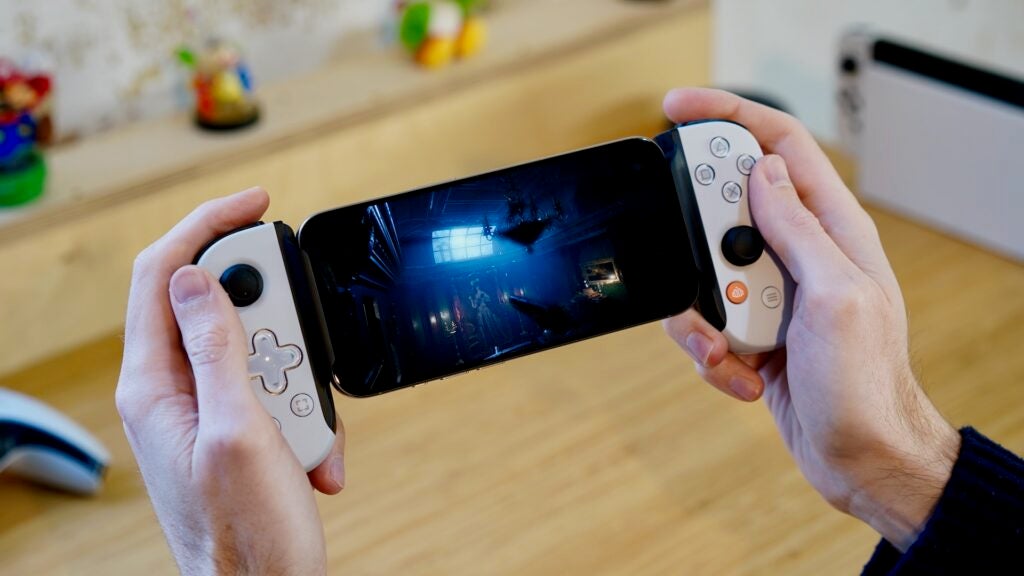
It comes down to the quality of the build and tightness of the tolerances on the buttons, as well as the quality and weight of the analogue sticks. The rear shoulder buttons have just the right level of spring and travel, enabling fine control whilst remaining sufficiently compact and mobile.
The true litmus test here is playing a console conversion like Wreckfest or Resident Evil Village, both of which I was able to pick up and play with virtually no adjustment period. There was none of that weird sense of disconnect that lesser controllers can engender, where it can often feel like you’re playing through a layer of control translation.
In terms of general performance, I experienced none of the occasional connection problems that our original review highlighted. Backbone has honed it product over the years with successive software – and now hardware – updates, to the point where it’s just about as dependable a package as they come.
Software
- Backbone app provides access to all your games
- TouchSync supports games with no controller support
- Streaming service support
The Backbone One is not, nor has it ever been, merely a mobile game controller. While it’s quality as a physical tool is important, it’s also a software service, or even a platform.
Backbone’s pitch is to bring the disjointed world of mobile gaming under one umbrella. Pressing that orange Backbone button will jump you into the Backbone app (once you’ve downloaded it of course), which serves as a highly polished window onto all of the available services and installed mobile games that are available to you.
The cross-hatched layout of this controller is reminiscent of the last couple of PlayStation UIs, which feels particularly fitting with this PlayStation Edition of the Backbone One.
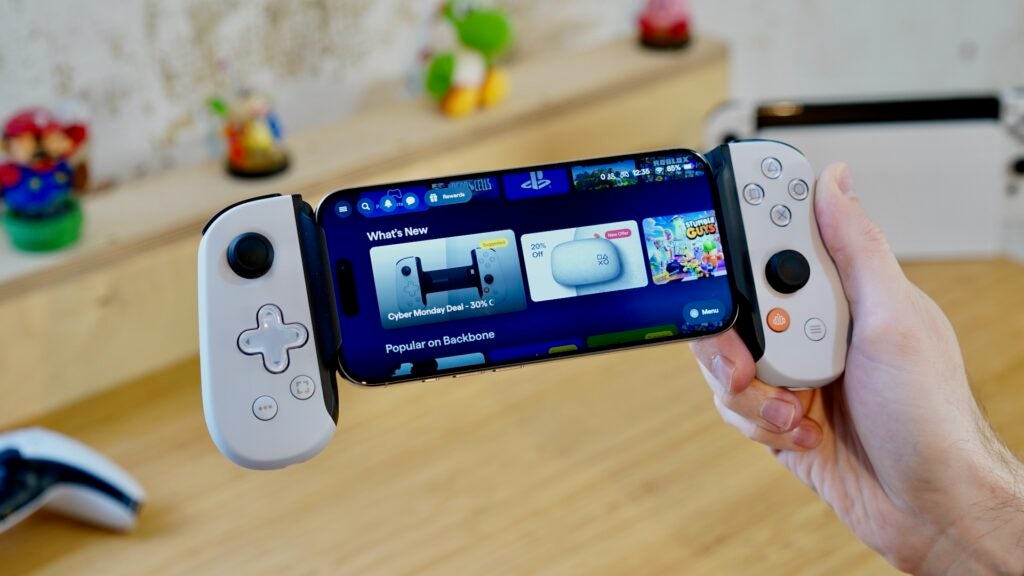
As well as a list of preinstalled games and services, there are magazine-like sections with slick auto-playing video intros to highlight new games you might want to try.
This being the PlayStation Edition, this includes PS Remote Play. Once you’ve installed the Remote Play app, your paired smartphone essentially turns into a PlayStation Portal, streaming PlayStation 5 and 4 games from your console to your screen.
Any hang-ups here are related to the PS Remote Play experience, and the general nature of game streaming. I won’t comment on things like latency and bit rates here.
What matters is how those PlayStation games translate through the Backbone One’s controls, and the answer is very well indeed. Obviously it doesn’t match the PlayStation feel of pairing an official controller, but then you do get the latency-lessening benefit of a direct USB-C connection here.
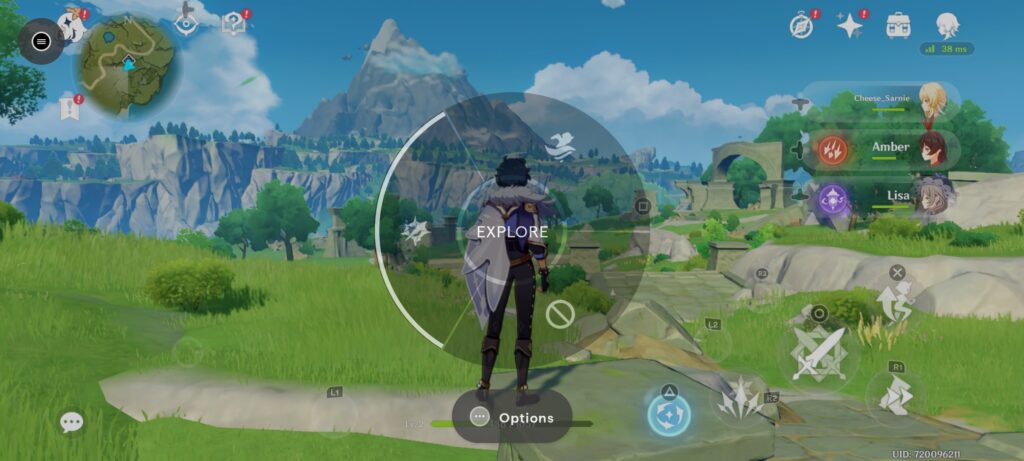
Despite the PlayStation branding, you can also make full use of Xbox Cloud Gaming on here – though if that’s your primary streaming service, you’ll probably opt for the regular Backbone One edition anyway, if only for those mirrored button layouts. There’s also a section on the Backbone UI for GeForce Now, if PC gaming is more your bag.
Elsewhere, the Backbone One (2023)’s software works hard to make regular mobile games better. For example, Genshin Impact – which doesn’t support controllers on Android – uses Backbone’s clever TouchSync software to automatically map its touch controls, giving you three hot-swappable configuration options.
I was startled at how seamlessly and fluidly this worked, instantly turning Genshin Impact on Android into a slick console action-RPG.
Latest deals
Should you buy it?
You want the best physical gaming controls possible
There is no mobile game controller with such classy, solid, and console-esque controls.
You’re on a budget
At £99.99/$99.99, you need to be darned sure you want a physical controller for your mobile phone.
Final Thoughts
The Backbone One remains arguably the finest mobile gaming accessory on the market. It offers the best set of physical controls around, while Backbone’s software works wonders to bring all of the disparate ways of playing games on your phone together under one slick UI.
Very little has changed with this second generation, and there was perhaps more that could have been done to improve the process of fitting it to your phone. But its physical compatibility is better than ever, and its core offering was already pretty immaculate.
At £100/$100, it might be a little expensive, but if you’re serious about high-end mobile gaming or game streaming, the Backbone One will justify its price over the coming years.
How we test
We test all our devices thoroughly over an extended period of time. We use industry-standard tests to compare features properly. We’ll always tell you what we find. We never, ever, accept money to review a product.
Find out more about how we test in our ethics policy.
Was tested for at least two weeks before the review.
Played and streamed multiple games with the controller.
Used with an iPhone 15 Pro and a Google Pixel 8
FAQs
It depends on the phone, but removing the magnetic adapters should allow you to use a lot of covers.
Yes, the Backbone One words with all phones with USB-C ports.
The Backbone One controller has USB-C port, enabling you to charge your phone as you play.
Verdict
The Backbone One (2023) is a subtle revision of the original, but it remains the best and most flexible mobile controller in the business – now with improved hardware compatibility.
Pros
- Excellent mobile gaming controls
- Improved and updated hardware compatibility
- Excellent all-encompassing UI
Cons
- Still expensive
- Can be fiddly to fit your phone
- Not very different from the original
-
Compatibility with all USB-C phonesYou can connect the Backbone One (2023) to all Android phones and the new iPhone 15 range via USB-C. -
No charging requiredThe Backbone One doesn’t require any power, though it does have a USB-C port for passthrough phone charging. -
Custom UIThe Backbone app offers a window onto all of your installed games and streaming services.
Introduction
The original Backbone One was and continues to be one of the best mobile gaming controllers on the market, but it’s getting on a bit now. It was beginning to look a little outdated and inflexible, at least from a hardware compatibility standpoint.
Cue the Backbone One (2023), with a small but meaningful list of improvements that promise to open the controller out to the entire current generation of smartphones.
Together with the subsequent arrival of a dedicated PlayStation edition, and a number of improvements to its clever streaming-focused software, we thought now would be the perfect time to revisit the Backbone One. Is it still the cream of the mobile gaming crop?
At the same price of £99.99, it still isn’t anyone’s idea of cheap. But in a world where the PlayStation Portal costs £200, can it now be considered good value?
Design
- Very similar to other models
- Prosaic but effective expansion system
- No power required
The Backbone One (2023) hasn’t changed much from the design of the original, which is absolutely fine. The first-generation product was arguably the best mobile game controller on the market, so a subtle revision is all that was needed.
This is still a simple controller with a contemporary console layout that expands and clamps onto your smartphone, gripping either side in a landscape orientation. The final amalgamation looks somewhat like a smaller Nintendo Switch, but with the only point of meaningful connection being the USB-C port on the right-hand control section.
Yes, in a post-iPhone 15 world, Backbone has gone all-in on USB-C. This current model is compatible with Apple’s latest smartphones out of the box, though older USB-C owners can also get in on the act via a software update.

Improved compatibility is the main reason for this revised model’s existence. Besides that USB-C port, the revised model has also slightly extended the bridge extension to make fitting larger phones that little bit more comfortable – though it’s still a bit of a fiddle until you get the knack.
I would have liked Backbone to have incorporated some kind of open lock and a gradual contraction system, as it always feels like I’m a slip away from a dinged phone frame (though this fear hasn’t yet manifested itself in reality).
Also new is the addition of swappable magnetic adapters. These clever little snap-on rubberised mounts come in two flavours, and help incorporate a wider range of phones. They too are a little fiddly to root out of their mountings, but I suppose that’s preferable to being too easy to remove.

My iPhone 15 Pro fit like a glove right out of the box. I found that neither magnetic set fitted the Pixel 8, with the left grip sticking on the chunky camera module before it could clamp onto the edge. My solution was to take the magnetic grips out entirely and use the Pixel 8 case, which worked nicely.
This is the PlayStation Edition of the Backbone One (2023), but Backbone’s claim that it’s “Inspired by the look and feel of the PS DualSense” seems fanciful. It’s a simple cosmetic decal switch, with a white and black finish and the signature PlayStation button names swapping in for the Xbox layout of the original.
You still get a 3.5mm headphone jack and a USB-C port on the bottom of the left and right handles respectively. The latter is there purely for passthrough charging of your phone, as the Backbone One (2023) doesn’t require any power of its own.
Performance and gaming experience
- Superb console-like gaming controls
- Slightly improved D-pad and buttons
- Top-notch build quality
Besides the aforementioned compatibility-based updates, the only other physical changes here relate to the physical controls. The 2nd gen controller D-pad and face buttons have been updated for additional precision.
Not that I would necessarily have noticed had Backbone not drawn attention to the fact. But yes, upon closer inspection and direct comparison with the first Backbone One, the D-pad seems to offer a more pronounced edge, while the buttons have a less tightly sprung clickiness to them.
Essentially, though, we’re looking at much the same gaming experience that the original Backbone One provided. This isn’t a knock. It’s still the best bespoke mobile game controller I’ve ever used.

It comes down to the quality of the build and tightness of the tolerances on the buttons, as well as the quality and weight of the analogue sticks. The rear shoulder buttons have just the right level of spring and travel, enabling fine control whilst remaining sufficiently compact and mobile.
The true litmus test here is playing a console conversion like Wreckfest or Resident Evil Village, both of which I was able to pick up and play with virtually no adjustment period. There was none of that weird sense of disconnect that lesser controllers can engender, where it can often feel like you’re playing through a layer of control translation.
In terms of general performance, I experienced none of the occasional connection problems that our original review highlighted. Backbone has honed it product over the years with successive software – and now hardware – updates, to the point where it’s just about as dependable a package as they come.
Software
- Backbone app provides access to all your games
- TouchSync supports games with no controller support
- Streaming service support
The Backbone One is not, nor has it ever been, merely a mobile game controller. While it’s quality as a physical tool is important, it’s also a software service, or even a platform.
Backbone’s pitch is to bring the disjointed world of mobile gaming under one umbrella. Pressing that orange Backbone button will jump you into the Backbone app (once you’ve downloaded it of course), which serves as a highly polished window onto all of the available services and installed mobile games that are available to you.
The cross-hatched layout of this controller is reminiscent of the last couple of PlayStation UIs, which feels particularly fitting with this PlayStation Edition of the Backbone One.

As well as a list of preinstalled games and services, there are magazine-like sections with slick auto-playing video intros to highlight new games you might want to try.
This being the PlayStation Edition, this includes PS Remote Play. Once you’ve installed the Remote Play app, your paired smartphone essentially turns into a PlayStation Portal, streaming PlayStation 5 and 4 games from your console to your screen.
Any hang-ups here are related to the PS Remote Play experience, and the general nature of game streaming. I won’t comment on things like latency and bit rates here.
What matters is how those PlayStation games translate through the Backbone One’s controls, and the answer is very well indeed. Obviously it doesn’t match the PlayStation feel of pairing an official controller, but then you do get the latency-lessening benefit of a direct USB-C connection here.

Despite the PlayStation branding, you can also make full use of Xbox Cloud Gaming on here – though if that’s your primary streaming service, you’ll probably opt for the regular Backbone One edition anyway, if only for those mirrored button layouts. There’s also a section on the Backbone UI for GeForce Now, if PC gaming is more your bag.
Elsewhere, the Backbone One (2023)’s software works hard to make regular mobile games better. For example, Genshin Impact – which doesn’t support controllers on Android – uses Backbone’s clever TouchSync software to automatically map its touch controls, giving you three hot-swappable configuration options.
I was startled at how seamlessly and fluidly this worked, instantly turning Genshin Impact on Android into a slick console action-RPG.
Latest deals
Should you buy it?
You want the best physical gaming controls possible
There is no mobile game controller with such classy, solid, and console-esque controls.
You’re on a budget
At £99.99/$99.99, you need to be darned sure you want a physical controller for your mobile phone.
Final Thoughts
The Backbone One remains arguably the finest mobile gaming accessory on the market. It offers the best set of physical controls around, while Backbone’s software works wonders to bring all of the disparate ways of playing games on your phone together under one slick UI.
Very little has changed with this second generation, and there was perhaps more that could have been done to improve the process of fitting it to your phone. But its physical compatibility is better than ever, and its core offering was already pretty immaculate.
At £100/$100, it might be a little expensive, but if you’re serious about high-end mobile gaming or game streaming, the Backbone One will justify its price over the coming years.
How we test
We test all our devices thoroughly over an extended period of time. We use industry-standard tests to compare features properly. We’ll always tell you what we find. We never, ever, accept money to review a product.
Find out more about how we test in our ethics policy.
Was tested for at least two weeks before the review.
Played and streamed multiple games with the controller.
Used with an iPhone 15 Pro and a Google Pixel 8
FAQs
It depends on the phone, but removing the magnetic adapters should allow you to use a lot of covers.
Yes, the Backbone One words with all phones with USB-C ports.
The Backbone One controller has USB-C port, enabling you to charge your phone as you play.



















